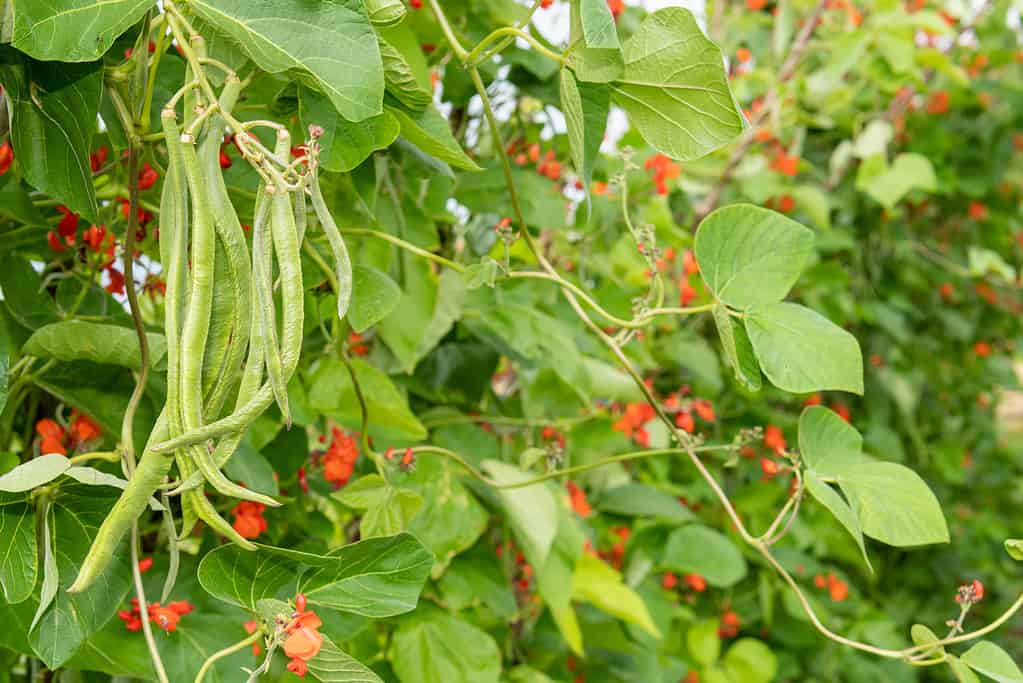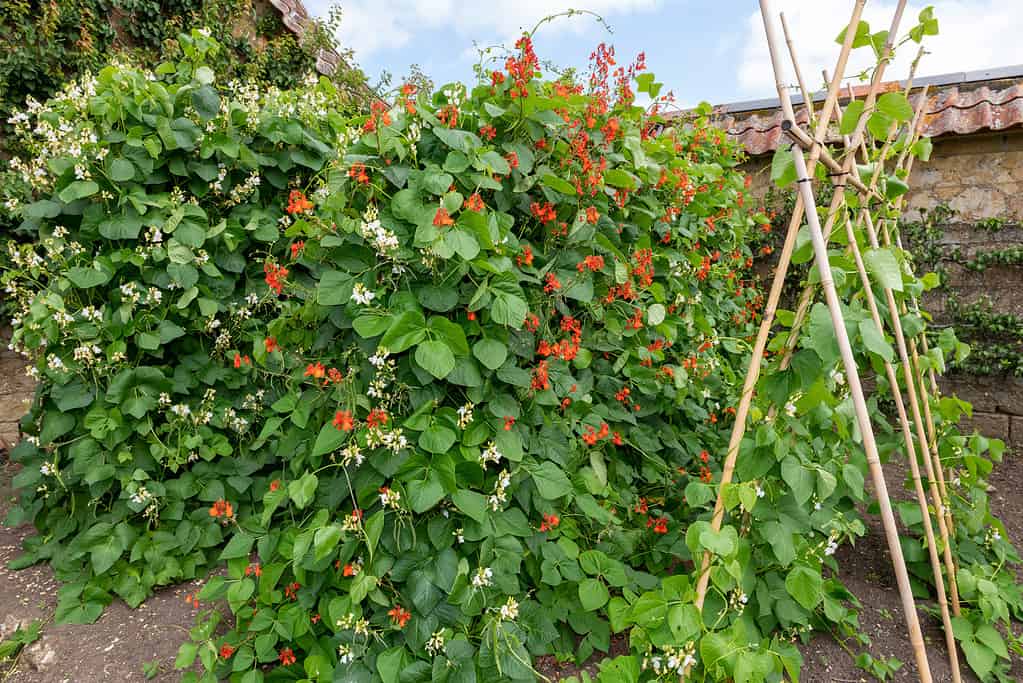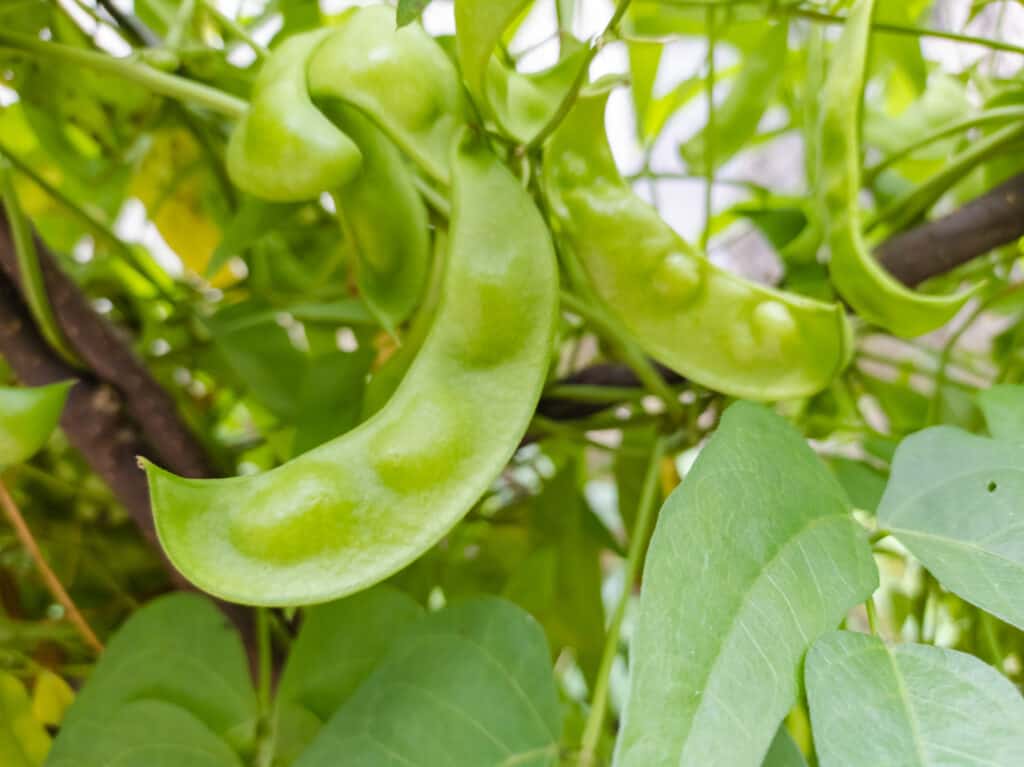Beans are one of the most important food sources globally, with over 300 million people around the world consuming them in various forms as part of their daily diet. Due to their diversity of culinary uses, they’re an excellent crop for home gardeners!
In this guide, we’ll cover the botanical classification of the bean, its native range, characteristics, growing requirements, how to direct sow the seeds, and how to transplant seedlings into your garden.
Alright, let’s jump in!
Beans: Botanical Classification, Native Growing Range, and Characteristics
Beans, rather than being one single species, are actually spread across a number of genera of flowering plants in the legume family, Fabaceae. In this guide, we’ll focus on the Phaseolus genus, which contains one of the most commonly grown and consumed beans. Currently, the Phaseolus genus contains 70 species of beans, five of which are domesticated and commonly consumed. These species are: Phaseolus vulgaris, Phaseolus coccineus, Phaseolus dumosus, Phaseolus acutifolius, and Phaseolus lunatus. The respective common names for these species are the common bean, the scarlet runner bean, the year-long bean, the tepary bean, and the lima bean.
This genus is primarily native to South and Central America, although a few species of beans are native to North America, such as P. acutifolius (tepary bean), which is native to the Sonoran Desert of Mexico.
Broadly speaking, you can categorize these five species by whether they can grow as bush beans, pole beans, or both. Bush beans describe plants that grow compactly on the ground and do not climb or require trellising. Pole beans, in comparison, are climbing plants that grow as vines and tend to need trellising or staking to support their upward growth. The common bean (P. vulgaris) produces varieties that grow as either pole or bush beans. The same is true for lima beans and tepary beans. Scarlet runner beans and year-long beans, however, are both strictly climbing plants.

Pole beans are climbing plants that grow as vines and tend to need trellising or staking to support their upward growth.
©iStock.com/Tom Meaker
How to Grow Beans
One of the most important pieces of info you’ll need before growing your beans is whether you have a bush or climbing variety. This will determine how you support the growth of your plant. After you have determined the growth habit of your bean plant, you’ll need to know what growing zones are suitable, its ideal soil and sunlight conditions, watering and fertilizing requirements, and how to direct sow its seeds and transplant from seedlings.
Below, we’ll cover all of this in-depth.
Bush or Climbing Variety?
First, you’ll need to determine if you’re growing a bush or climbing variety. You’ll also see climbing beans referred to as pole or runner beans. Climbing beans grow as vines and need a fence, trellis, or staking for support as they grow upward.
There are a number of ways that you can build support structures for climbing bean plants. One method is to pound three at least 5-foot-high stakes into the ground and tie the tops together. You can also install a trellis which you can either buy or build. To build, create a moveable fence frame and cover it with chicken wire. Some gardeners also simply purchase tomato cages for their climbing beans. You can be creative, so think about what will work best for your garden space and budget, and then go for it!

One method of building support for your climbing beans is to pound at least 5-foot-high stakes into the ground and tie the tops together.
©iStock.com/Tom Meaker
USDA Hardiness Zones for Beans
You can grow beans in all of the USDA Growing Zones, but you will need to choose an appropriate species and variety for your growing range. For example, lima beans do best in warm regions where they can grow in temperatures above 75 degrees Fahrenheit. Scarlet runner beans, however, are native to cooler, higher-elevation regions of Mexico and Central America, so they can handle cooler growing conditions.
How to Grow Beans: Ideal Soil Conditions
The best soil for all bean species is light, loamy soil that is fertile, moist, well-draining, and slightly acidic to neutral (6.0-7.0 pH). However, some varieties are hardier than others to a range of soil types, so make sure you understand what your specific plant needs. Lima beans, for instance, germinate slowly and don’t tolerate soggy, cool soils. The common bean (P. vulgaris), however, is hardier to less-than-ideal soil types, especially clay-based soils.
Ideal Sunlight Conditions
As warm-loving plants, all bean species do best in at least 8 hours of full sunlight. This is especially important when growing beans in cooler climates where the sun’s intensity is not as strong.
How to Grow Beans: Watering Requirements
Beans need a moderate amount of water during their growing phase to produce their bean pods and thrive. If you direct sow bean seeds into the ground, you’ll want to water them every day until germination occurs. After the seedlings have emerged, reduce watering to 2-3 times per week. These plants generally need about 1 inch of water per week, which equals about half a gallon of water per square foot of the garden bed. Your goal is to keep the soil moist, but not soggy.
Fertilizer Requirements
Beans don’t tend to require a lot of fertilizer, so if you have fertile soil, your plants will likely have all they need. For soil types that are less healthy in terms of microbial populations, you can incorporate an inch of well-aged compost into the top 6 inches of the soil prior to planting.
How to Grow Beans: Direct Sowing Seeds into Your Garden
When you plant your bean seeds will depend on the species/variety and your climate. Beans are warm-loving plants, so direct sowing seeds in Zones 1-6 isn’t as viable. If you live in Zones 7-12, you should be able to find a variety that works well in your climate to direct sow into the garden.
For example, when direct sowing lima bean seeds, it’s best to wait about two weeks after the last frost of the season has passed. The soil temperature should be at least 70 degrees for seed germination. Depending on the variety of lima beans, you can expect to harvest in 60-95 days. Across the board, bean seeds are slower to germinate, and take around 7-14 days at temperatures between 65-85 degrees Fahrenheit.
You can plant most bean seeds at a depth of 1″ and 2″ apart. Rows should be 24″-36″ apart. When and at what spacing you thin bean seedlings will depend on the species. For example, when bush varieties of P. vulgaris are about 3 inches high, you can thin the plants to 4 inches apart.
For climbing varieties, you can also plant seeds at the base of a trellis or pole, rather than in rows. For example, if you choose to use the three poles tied together method, you can plant 2 seeds at the base of each pole, and thin out the weakest plants when they reach 4-6 inches high. As the plants grow, gently guide them to grow up and around the poles.

As warm-loving plants, all bean species do best in at least 8 hours of full sunlight.
©Rulli Yulianto/Shutterstock.com
How to Transplant Bean Seedlings into the Garden
If you live in climate Zones 1-6, your best bet is to start bean seeds indoors and then transplant them into your garden, or purchase seedlings from a nursery. You should wait until temperatures are consistently at least 70 degrees Fahrenheit during the day and no less than 45 degrees Fahrenheit at night. At this point, they should have 4-5 mature leaves on them. To ensure they have a smooth transition from indoor containers into your garden bed, your seedlings will need to be acclimated to outdoor conditions before transplanting.
This process takes about a week and entails gradually increasing the time your seedlings spend in full sun and in cooler nighttime conditions. By the end of a week, your plants should be happily sitting in full sun and spending the night outdoors. Once they’re ready for transplanting, choose a mild, overcast, non-windy day and plant them into holes about an inch deeper than their containers. Space them 4-6 inches apart.
The photo featured at the top of this post is © iStock.com/wahid hasyim asyari
Thank you for reading! Have some feedback for us? Contact the AZ Animals editorial team.






